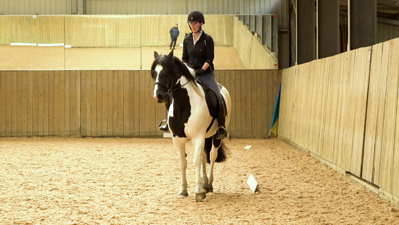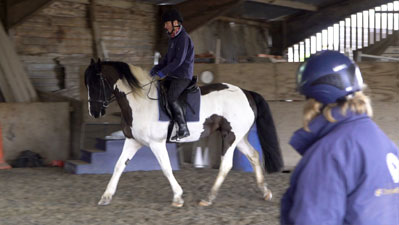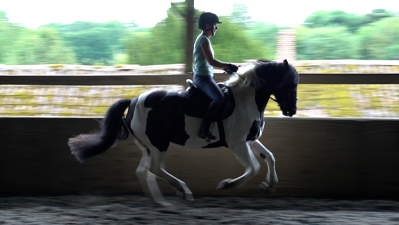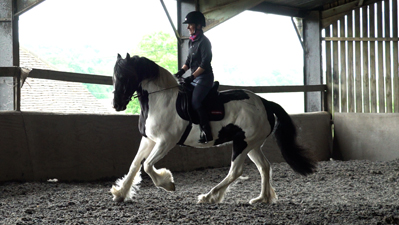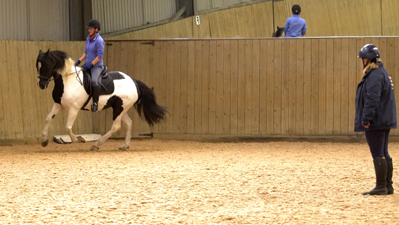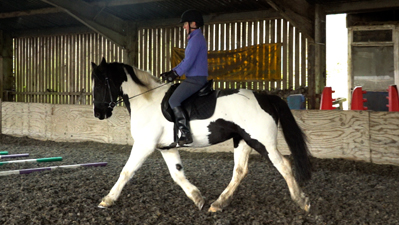
- Leg yield in walk and trot
- Collected trot
- Working trot
- Shoulder in
- Counter canter
The session begins by looking at the groundwork and assessing the starting point for Chantal and Mia.
In ridden work, Chantal already has good alignment and has been working on her 'boards'. Mia tends to have 'kinks in her hosepipe' which stops her from being straight and reaching into the reins.Ali shows Chantal 'hands up against a resistance' to help when Mia tries to go on to the forehand. Chantal thinks of 'slingshot' to connect into Mia's back legs and make her push from her hind legs in trot.
Chantal has been feeling that Mia has been stiff in her neck. Ali thinks this is due to Mia bracing with her liking to be 'stiffly-not-quite-straight' rather than 'softly-straight'. Ali gets Chantal to do wiggly lines asking Mia to bend and fall out through both shoulders, effectively 'jack-knifing' both ways.
In canter, Ali gets Chantal to think about maintaining her position and just changing Mia's legs into canter. She also describes 'bouncing the ball'. Mia goes into a fantastic canter and Chantal wonders what has happened to her horse!
Straightness is the key to getting Mia going nicely and its obvious that Chantal has been practicing this in both walk and trot. With transitions, Chantal has been thinking about 'just changing the legs' and this makes for some great changes.
Ali gets Chantal to practice leg yield in both walk and trot. Chantal has to remember to say to Mia with her aids 'Please - do it!' not 'Please, please, please.....'.
In canter, Chantal works on 'bouncing the ball up' rather than Mia running off with the ball!
The session starts with Ali checking Chantal's position and making sure Mia is taking long strides in walk and trot.
Chantal and Mia practice trot walk and trot halt trot transitions. Ali does some 'reactivity' training in the transitions to make Mia more responsive. Mia's likes to go 'head first' rather than 'bum first' in the transitions. Chantal has to focus on her position, keeping her front short and 'plugging in' not 'water skiing' or clenching her butt!
In canter and canter transitions, Chantal has to focus on 'bouncing the ball', in particular just before the canter trot transition. By the end of the session, Chantal is delighted with Mia's canter and the transitions!
Ali mentions that it's worth looking at walk/halt to discover problems, because whatever problems appear in walk/halt will appear in the trot/walk, canter/trot transitions too. They then move on to little walk—big walk, then little trot—big trot, keeping the 'balloon inflated'. Ali talks about the 'big' only being as good as your 'little', and using these movements to improve transitions as well as paces.They think about 'coiling the spring', then releasing it, and of keeping the energy in the 'little' version of the gait.
They then look at how the new trot affects the canter. They work on 'slingshot' in the trot/canter transition, and on playing basketball rather than Mia's preferred sport of rugby!
To improve Mia's trot, Ali gets Chantal to think about 'passage' and this gets some fantastic trot. Chantal practices trot-walk-trot transitions trying to think about 'passage'.
They then look at medium trot, thinking about 'slingshot' and 'suctioning up'. Chantal has to get a little trot, coil the spring and then let Mia 'down the stair and down the stair' so Mia can lengthen her neck. Mia would much rather canter but does show some lovely strides of medium trot!
Ali suggests that Chantal thinks about 10m loops as if they are serpentines to avoid them getting 'leg yieldy'. Chantal has to take into consideration Mia's dislike of bending right which means Chantal can't ride the loops as the text book would advise! Mia does some lovely loops in trot on both reins and is ready for their next dressage test!
Chantal has been practicing 'little and big' with the aim of getting medium trot. In 'little' trot, Chantal has to focus on 'slingshot' and lots of 'suction' to get Mia to bring her bum under her. In 'big' trot Chantal has to maintain 'narrowness' as well as pushing forward with her hands and 'resisting my push'. To get medium trot, Mia has to be rev'ed and on the edge of canter. Chantal has to also think about 'suctioning the withers up'. She also has to make sure that she remembers to bring back the trot to normal after medium.
They do a check of ‘Go’, ‘Stop’ and ‘Back’ and check that they can keep a rhythm in the walk.
Mia’s 'Back' is good, but she puts her neck up and tucks her nose in so she doesn’t really engage her back. This happens under saddle too. When Mia’s neck is long, she finds ‘back’ hard, they practice 'Back' with a 'head lower' command too to encourage Mia to engage her back.
They swiftly move on to leg yield. Mia finds going sideways and forward tricky, but she focuses on Chantal really well.
Going left is easier for Mia, which is surprising to Chantal because ridden they find going left harder. Ali explains that that might say something about Chantal’s own asymmetry, demonstrating how useful groundwork is for examining where ridden issues might stem from.
The steps become more stilted, the harder Mia finds it. She wants to rush off past Chantal, so Chantal has to be really firm and not allow Mia to sit on her hands on a ‘three’, and also not allow Mia to push her and increase the speed.
When you’re training, you should always be trying to notice what would make it better and think about that, which helps to focus the handler / rider on what really makes a difference to the training. Intention and thought really make a huge impact when training ridden and groundwork.
Chantal has been thinking about feeling like she was leaning back in the canter, and ‘sitting on the outside hind’ to get the canter better. She’s also been using leg yield whilst hacking to improve the trot.
During the session Ali recommends focusing on Mia's length of stride to get a real impression of the length of Mia's neck, as the two elements go together. In trot thinking of slightly slower is how she will gear change in to the longer stride, long and slow is what will get you passage which will be harder for Mia than piaffe.
In leg yield Chantal finds keeping Mia engaged and her head down tricky. Ali explains that this is about rhythm. Once the rhythm is established Mia will be able to keep her head down.
Medium trot is getting closer and closer without even trying to work on it. By practising little and big, and leg yield you are practising the biomechanics needed for her to be able to do medium trot.
In canter naturally a horse wants to throw everything on to the inside fore, but we want them to load the outside hind.
They have been working on laterals in the school, and little and big whilst hacking.
Chantal has to think basketball not rugby in trot as well as in canter. She says the straightness has become normal now, she hardly has to think about it. On the right rein there is a little too much rib cage right and a little bit nose left, which is possibly a little bit of overkill of not wanting the rib cage left.
They take a look at little and big as a refresher and as a move towards medium trot. Mia wants to rush a little on the left rein to begin with. You big will only ever be as good as your little.
On the right rein Mia wants to rush even more than on the left. Imagine you could piaffe, slingshot, narrowness, suction. think as if you’re going to leg yield left to get the narrow boundary on the right.
Mia gets heavy in Chantal’s hands at one point, Ali’s advice is to go to a four of pressure rather than sticking on a three and battling and holding on. If you pull and nothing happens and continue for more than two strides you will untrain the stop. To resolve it you can go to a four for the aid, and then soften, if she still wants to charge on, apply the four again to remind her what the aid means.
If you can keep her straight when you go from little to big, you’ll get that great push off.
In canter Chantal has to think of leaning back in to canter - which is a slingshot, pull buttons back sort of feeling. Canter left is great and Chantal is vertical. It’s a great first canter and Chantal doesn’t have to think quite so much of leaning back as she did.
On the right rein the straightness is extra important. Weight on her left hind in canter. Naturally most weight on leading leg, but we want most of the weight in the opposite hind leg.
Chantal and Mia return. They have ridden throughout lockdown, although not in an arena. In this session they think about straightness, how it effects transitions, little and big trot, leg yield, and walk-canter transitions.
Mia has some great push off going big from little trot, and they look at some sitting trot corrections within this. On the right rein it’s easier to achieve good little to big, and Ali says the key to it being as good on the left rein is straightness.
In the leg yield left Mia like to turn her neck right, but tilt her nose left, poll right. They make some corrections and get some super working trot afterwards. Ali explains that Mia is fixing her neck, so that is the next correction. Once the neck is as straight as her body, she’ll have softness and roundness, and that is the next step, which Chantal and Mia are close to now. On the right rein Mia wants to dive through her shoulder, Chantal thinks about the first step being the hind leg. Counter-flexion on the turn helps to fix this.
Mia finds walk-canter tricky. Ali advises that Mia on the edge of jog is what will get them a good walk-canter. Mia likes to put in one or two steps of trot before the canter, or she tries striking off with the incorrect lead on the right rein. The left rein walk-canter transitions are easier for Chantal and Mia to achieve because Mia is straighter. There’s a lot for Mia to think about, the first question is clean walk-canter, the second if the correct lead.
Chantal has been pleased with Mia’s schooling. They’ve been working on medium and collected trot, still working in the paddock. Chantal has been focusing on getting to the top of her rise, and making the rise ‘bigger’. She says that she needs to ‘relax’ as well as have tone, after watching a video of her last test, which she says her tension was being transfered to Mia.
They also look at trot-halt, rein back, extended walk.
In early Sept, the day before she was due to compete in her first elementary competition, Mia tore the Manica Flexoria of her back right fetlock. She had keyhole surgery three months ago, followed by two weeks box rest, and since then has had a gradual return to in hand work.
Chantal says that in the in hand work Mia has more ‘go’ than ‘whoa’. Chantal has been using little and big to get Mia to steady and focus. They review this in the session which helps encourage Mia to engage her abs.
They then look at leg yield, first one way, then back the other which allows Chantal to see and feel the contrast between each direction. Going left is straighter than going right where Mia would like to dive on her right shoulder. Ali gives some suggestions to fix this. Getting leg yield straight in hand will make it better ridden, because the horse is finding their own self carriage, not relying on the rider. Stepping back in to halt is called for if Mia wants to run on and not stop.
They then work on quarters towards the handler, which is one of the tools required for travers, and is very useful for mounting. Mia struggles to begin with, offering a few different types of stepping away before understanding that Chantal wants her to step her hind legs towards her, which she then demonstrates brilliantly.
They have a look at where Chantal & Mia are after the break, and think about small adjustments to get Chantal back to where she left off. With a couple of reminders about ‘buttons to plaits’ Chantal picks up a great prelim/novice trot, although on the right rein Mia would be more inclined to plough on to the forehand.
To get to what Chantal calls ‘magic trot’ she needs to be more 'narrow on her right', particularly on the back of her right side, which helps keep Mia straight.
Mia would like to flex left, thinking leg yield left in every step on the left rein really helps prevent this.
In canter Mia would like to charge off on the right rein and Chantal ends up leaning back a bit in the effort to prevent Mia tanking off. Thinking of ‘pulling lower buttons back’ resolves this and the left rein canter is then great from the start.
Mia & Chantal have been out competing at Novice and are planning on doing an Elementary test, which Chantal is keen to ride through in this session. Medium trot is proving hard to establish at the moment, but Chantal has decided to work on improving the other movements for the moment. She comments that the canter is now getting better marks in tests than the trot, which shows how much the canter has improved since they started training with Ali.
This session covers 'little & big' trot, trot-walk-trot transitions, 10m circles in trot, canter, and riding an elementary dressage test.
The session clearly illustrates how important straightness is to improving all gaits. Mia's canter is much improved towards the end of the session and Chantal is thrilled with the change.
This session includes some great footage on the following:
Medium walk, Trot-walk-trot, rein back, medium trot & the theory of 'tea-tray'/'tractor bucket'.
Chantal has been out competing at Elementary level, progressively improving, but ironically the trot has now become the pace that is the challenge. Previously canter would have caused more trouble. To improve the trot work in tests Ali & Chantal work on the difference between collected and working trot, and on leg yield to help set them up. The session also looks at shoulder in in walk, and trot, discussing their recent test, how figure of eights can help counter canter.
ABOUT CHANTAL AND MIA
CHANTAL
Chantal loved riding from an early age, but didn’t get her first horse until she was 27 years. 20 years on and she’s realised that staying on and working in partnership with a horse are more important and more fun than jumping big fences or trying to change spooky horses. She bought Mia in 2015 to have a bit a fun with and has since discovered the magic of cobs.
MIA
Mia is a 15.2hh cob who lives out all year round, in a field at the end of Chantal’s garden. She is now 14 years old and is planning on living for ever. Her mission in life is to show other horses how to be relaxed and do a nice dressage test without getting stressed. She loves performing in front of large crowds and is growing her international webinar fan base, because cobs can!

